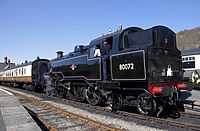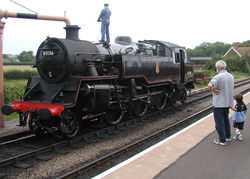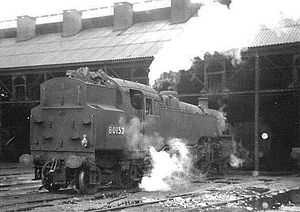BR Standard Class 4 2-6-4T
| BR standard class 4 tank | |
|---|---|
|
80152 at Nine Elms MPD, 1965. | |
| Type and origin | |
| Power type | Steam |
| Designer | R.A. Riddles |
| Builder |
Brighton Works (130) Derby Works (15) Doncaster Works (10) |
| Build date | July 1951 – November 1956 |
| Total produced | 155 |
| Specifications | |
| Configuration | 2-6-4 T |
| UIC classification | 1′C2′ h2t |
| Gauge | 4 ft 8 1⁄2 in (1,435 mm) |
| Leading wheel diameter | 3 ft 0 in (0.914 m) |
| Driver diameter | 5 ft 8 in (1.727 m) |
| Trailing wheel diameter | 3 ft 0 in (0.914 m) |
| Length | 44 ft 10 in (13.67 m) |
| Width | 8 ft 9 1⁄4 in (2.67 m) |
| Height | 13 ft 0 in (3.96 m) |
| Axle load | 17.95 long tons (18.24 t) |
| Weight on drivers | 53.05 long tons (53.90 t) |
| Locomotive weight | 86.65 long tons (88.04 t) |
| Fuel type | Coal |
| Fuel capacity | 3.50 long tons (3.56 t) |
| Water capacity | 2,000 imp gal (9,100 l; 2,400 US gal) |
| Boiler | ABR5 |
| Boiler pressure | 225 psi (1.55 MPa) |
| Firegrate area | 26.7 sq ft (2.48 m2) |
| Heating surface: – Tubes and flues | 143 sq ft (13.3 m2) |
| – Firebox | 1,223 sq ft (113.6 m2) |
| Superheater area | 240 sq ft (22 m2) |
| Cylinders | Two, outside |
| Cylinder size | 18 in × 28 in (457 mm × 711 mm) |
| Performance figures | |
| Tractive effort | 25,100 lbf (111.7 kN) |
| Factor of adhesion | 4.65 |
| Career | |
| Operator(s) | British Railways |
| Power class | 4MT |
| Number(s) | 80000–80154 |
| Axle load class | Route availability 5 |
| Withdrawn | July 1962 – July 1967 |
| Disposition | 15 preserved (list), remainder scrapped |
The British Railways Standard Class 4 tank is a class of steam locomotive, one of the BR standard classes built during the 1950s. They were used primarily on commuter and outer suburban services.
Background
On the nationalisation of British Railways (BR) in 1948 the London Midland Region had a number of ex-London, Midland and Scottish Railway 2-6-4T and the Western Region a number of GWR Large Prairie 2-6-2T types. These tank engines were particularly suited to commuter and secondary services. However, particularly in Scotland and the Southern Region, the situation was not so good with large numbers of pre-grouping types struggling on.
Design and construction

On the decision to build the BR standard series of locomotives, a series of class four tank engines was ordered, based on the ex-LMS Fairburn 2-6-4T with some modifications. The lineage of the class could therefore be tracked through the LMS/BR Class 4 2-6-4T locomotives back to the Fowler design of 1927.
Design work was done at Brighton, the overall programme being overseen by R.A. Riddles. The principal modifications to the Fairburn design involved the reduction of their envelope to enable them to fit into the L1 loading gauge. To do this the tanks and cab were made more curved than the Fairburn design, the Fairburn having a straight-sided tank. The biggest mechanical change was a reduction in cylinder size, also to reduce cross-section, and a corresponding increase in boiler pressure to compensate. Other visible changes include the reintroduction of plating ahead of the cylinders.
130 of the class of 155 were built at Brighton, 15 (80000–80009, 80054–80058) at Derby Works and 10 (80106–80115) at Doncaster Works between 1951 and 1956. The first to emerge was 80010 from Brighton in 1951. Fifteen that were due to be constructed in 1957 were cancelled due to impending dieselisation, and the last five would have been too had they not been at an advanced stage of construction when the order came to cancel them.
No significant modifications were made to the design. The tank vent was found to restrict the driver's vision and was moved further forward from 80059. Initially built with fluted coupling rods, these caused problems on other classes and from 80079 plain section coupling rods were substituted.
The BR standard class 4 4-6-0 was essentially a tender engine derivative of the Standard Class 4 tank.
Service
The Standard 4 tanks were originally allocated to all regions of British Railways, except the Western. They became particularly associated with the London, Tilbury and Southend Line (LT&S) working commuter services out of London until that route was electrified in 1962. They were also widely used in East Sussex and Kent working from Brighton, Tunbridge Wells and Three Bridges on those lines of the former London Brighton and South Coast Railway that were not electrified. Another group worked from Polmadie depot in the Scottish region on the Glasgow commuter services. Note that from July 1962, a batch displaced by electrification of the LT&S was transferred to the Western Region's Swansea (East Dock) and Shrewsbury districts, as well as other regions.
Accidents and incidents
- On 24 April 1956, Locomotive No. 80119 was derailed at Scalby, Yorkshire when the track spread under it whilst shunting. An instruction banning heavy locomotives from shunting at Scalby had been forgotten.[1]
- On 30 January 1958, locomotive No. 80079 was hauling a passenger train that overran signals and was in a rear-end collision with another passenger train at Dagenham, Essex. Ten people were killed and 89 were injured.
- On 18 April 1961, locomotive No. 80075 was hauling a passenger train that was derailed at Pitsea, Essex due to a pointsman's error during single line working.[2]
- On 9 December 1962, locomotive No. 80102 was derailed at Gosport, Hampshire due to vandalism.[3]
Withdrawal
In the 1960s there was a mass withdrawal of steam locomotive classes. Older types were withdrawn in preference to the Standard 4s, which class remained intact until 1964. The final nine were withdrawn from the Southern Region on 9 July 1967. One Scottish Region example, 80002, remained in Glasgow past the end of steam haulage until 1969 as a static carriage heating boiler.
No. 80103 was withdrawn in 1962 after being reported for rough riding. It was towed between two other locomotives to Stratford Works, where it was discovered that the mainframe was broken in half. Considered beyond economic repair, 80103 was withdrawn and scrapped. It was the first of the 'Standard' locomotives to be withdrawn and the only one scrapped at Stratford.
Operation in preservation
Of the fifteen engines to survive into preservation, four have seen mainline operation: Nos. 80079, 80080, 80098 and 80135. Three of these were occasional mainline performers around the '90s with 80080 being originally used on LU steam on the met trips. 80080 also became the first steam engine to work a normal stopping passenger service on the mainline for over a quarter of a century back in March 1993, she worked for over a week on the Settle and Carlisle line working from Carlisle to Kirkby Stephen and back. She also returned to the famous Cambrian network in 1992. In 1994 80079 Joined up with 80080 to work a number of steam specials including a run over the Cambrian Coast Line. The deadline was so tight in fact that 80079 had not being able to receive her full BR Black lining out and was only able to run in unlined black. One notable incident was when 80080 with 80079 banking from the rear worked the climb up the 1 in 37 to Exeter Central. When near to the summit, 80080 lost its footing on the climb and stalled the train. The resulted continuous wheelspin from 80080 resulted in damage to both the track and the locomotive. It was only after the crew had hand-sanded the rails for both engines that they managed to get the train over the summit past Exeter Central.
In 1998, 80079 became the first steam locomotive to work a steam special down the Conway Valley line to Blaenau Ffestiniog since 1967. On the first run however, 80079 stalled near Pony Y Pant with six coaches, and as a result, a second attempt was made with only four coaches, which was successful.
80079 returned to Blaenau in 1999 with 80098. However, 80079 again stalled near Pony Y Pant, resulting in assistance from 80098, which had been waiting at Llanwrst with the second portion of the train. 80098 was therefore uncoupled, ran light engine up to Pont Y Pant, and helped bank the first portion up to Blaenau. The pair then returned to Llanwrst for the other four coaches, which they double headed up to Blaenau. The train was then reformed to eight coaches, and the combined service returned to Llandudno Junction in the dark.
80135 has being mainly used on the Whitby to Grosmont workings on the North Yorkshire Moors Railway.
At present, no BR Standard 4 tanks are mainline certified. However that is due to change soon as 80135 is soon due out from her overhaul at Grosmont works for use once again between Grosmont and Whitby, With Battersby being visited during galas. 80080 although talk was considered previously will not be returning for mainline use again and neither will 80098. 80079 was rumored to be from its new owner Jeremy Hosking but nothing has being officially confirmed yet as the engine requires a heavy overhaul first and then the fitment of TPWS, GSM-R & OTMR which is not cheap to fit.
Locomotives
No fewer than fifteen Standard Four tanks have survived the cutter's torch. This is the highest number for any preserved BR standard class, and is second only to the now 18 strong LMS Black Fives as the most preserved main line type, unless the Bulleid Light Pacifics are counted as one class (there are twenty Light Pacifics in preservation). All but three (80097, 80100 and 80150) have operated in preservation.
| Details of preserved engines | |||
|---|---|---|---|
| Number | Image | Home | Status |
| 80002 | |
Keighley and Worth Valley Railway | Boiler certificate expired in August 2013. Awaiting overhaul |
| 80064 |  |
Bluebell Railway | Awaiting major overhaul |
| 80072 |  |
Llangollen Railway | Undergoing Boiler Repairs |
| 80078 |  |
Privately Owned | Under overhaul |
| 80079 | |
Severn Valley Railway | Cosmetically restored in The Engine House. |
| 80080 | .jpg) |
Midland Railway - Butterley | Operational at the East Lancashire Railway |
| 80097 | East Lancashire Railway | Currently under restoration. | |
| 80098 |  |
Midland Railway - Butterley | Awaiting Overhaul. |
| 80100 |  |
Bluebell Railway | Awaiting restoration from ex-Barry condition. |
| 80104 |  |
Swanage Railway | Operational. |
| 80105 |  |
Bo'ness and Kinneil Railway | Boiler certificate expired 2010. Undergoing major 4-year overhaul. |
| 80135 |  |
North Yorkshire Moors Railway | Currently under overhaul. 80135 is the only 4MT to carry lined BR Brunswick Green, a livery not carried by any 4MT's in BR service. Will be fitted with TWPS for main line use between Pickering and Whitby when finished. |
| 80136 |  |
Crewe Heritage Centre | Boiler ticket expired in 2008, and currently nearing the end of a major 10-year overhaul at Crewe Heritage centre |
| 80150 | Mid Hants Railway | Awaiting restoration from Barry scrapyard condition. Swapped to the MHR by the Vale of Glamorgan District Council in exchange for the ex-Bricklayers Arms turntable. | |
| 80151 | _Bluebell_Railway_27_Sept_2010.jpg) |
Bluebell Railway | Static display. Boiler ticket expired in May 2012 |
References
- ↑ Hoole, Ken (1983). Trains in Trouble: Vol. 4. Redruth: Atlantic Books. p. 32. ISBN 0 906899 07 9.
- ↑ Hoole, Ken (1982). Trains in Trouble: Vol. 3. Redruth: Atlantic Books. p. 45. ISBN 0-906899-05-2.
- ↑ Bishop, Bill (1984). Off the Rails. Southampton: Kingfisher. p. 85. ISBN 0 946184 06 2.
- Bradley, Rodger P. (1984). The Standard Steam Locomotives of British Railways. David & Charles Publishers plc.
- Chancellor, Paul J. (December 1997). Taylor, R. K., ed. A Detailed History of British Railways Standard Steam Locomotives: vol 3 Tank Engine Classes. Railway Correspondence and Travel Society (RCTS). ISBN 0-901115-77-0.
External links
| Wikimedia Commons has media related to BR Standard Class 4 2-6-4T. |
- Preserved engines
| ||||||||||||||
